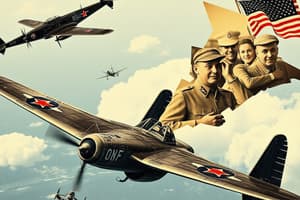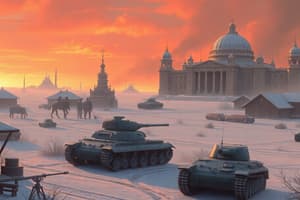Podcast
Questions and Answers
The American victory at Iwo Jima was made possible, in part, by?
The American victory at Iwo Jima was made possible, in part, by?
the transmission of vital battlefield information to American forces by Navajo code talkers
What was a consequence of the Dolittle raid?
What was a consequence of the Dolittle raid?
The raid convinced Japanese commander Yamamoto to engage American forces in the Battle of Midway in an effort to defend Japan's home islands from American bombers
This battle was a turning point in the Pacific war that relieved the Japanese threat to the U.S. Navy base at Honolulu?
This battle was a turning point in the Pacific war that relieved the Japanese threat to the U.S. Navy base at Honolulu?
The Battle of Midway
U.S. strategy during the Second World War called for?
U.S. strategy during the Second World War called for?
In 1942, why did Prime Minister Winston Churchill reject Stalin's appeal for a second front against Germany?
In 1942, why did Prime Minister Winston Churchill reject Stalin's appeal for a second front against Germany?
Which event stalled German advances in eastern Europe and placed German forces on the defensive for the rest of the Second World War?
Which event stalled German advances in eastern Europe and placed German forces on the defensive for the rest of the Second World War?
To become the 'great arsenal of democracy,' the United States had to?
To become the 'great arsenal of democracy,' the United States had to?
The primary task of the War Production Board was to?
The primary task of the War Production Board was to?
In its effort to persuade American business to convert from civilian production to military production, the U.S. government did what?
In its effort to persuade American business to convert from civilian production to military production, the U.S. government did what?
Which is true of government military contracts during the Second World War?
Which is true of government military contracts during the Second World War?
What impact did the Second World War have on American industry?
What impact did the Second World War have on American industry?
The Manhattan Project refers to?
The Manhattan Project refers to?
Issued by President Roosevelt in 1941, what did Executive Order No. 8802 do?
Issued by President Roosevelt in 1941, what did Executive Order No. 8802 do?
Which was a feature of the bracero program?
Which was a feature of the bracero program?
Which is true of Rosie the Riveter?
Which is true of Rosie the Riveter?
During the Second World War, women?
During the Second World War, women?
What did the federal government do to help workers in defense plants during the Second World War?
What did the federal government do to help workers in defense plants during the Second World War?
In the matter of closed- versus open-shop arrangements in industry, what did the National War Labor Board do?
In the matter of closed- versus open-shop arrangements in industry, what did the National War Labor Board do?
Which is true of the War Labor Disputes Act of June 1943 (Smith-Connally)?
Which is true of the War Labor Disputes Act of June 1943 (Smith-Connally)?
By the end of the Second World War, how did the United States achieve 40 percent of the world's weaponry production?
By the end of the Second World War, how did the United States achieve 40 percent of the world's weaponry production?
In producing Liberty ships, Kaiser shipyards emphasized?
In producing Liberty ships, Kaiser shipyards emphasized?
During the Second World War, how did the United States compare to other major combatants regarding direct warfare?
During the Second World War, how did the United States compare to other major combatants regarding direct warfare?
Why did the War Production Board redesign men's suits during the Second World War?
Why did the War Production Board redesign men's suits during the Second World War?
Which is true of the Office of Price Administration?
Which is true of the Office of Price Administration?
Why was sugar rationed in the United States during the Second World War?
Why was sugar rationed in the United States during the Second World War?
The Office of War Administration was created for which reason?
The Office of War Administration was created for which reason?
How did some movie theaters support the war effort against Germany and Japan?
How did some movie theaters support the war effort against Germany and Japan?
During the Second World War, the personal income of most American workers?
During the Second World War, the personal income of most American workers?
Which statement concerning the wartime economy is true?
Which statement concerning the wartime economy is true?
As a result of racial tension between Mexican American gang members and white sailors and soldiers in 1943, what did the city of Los Angeles outlaw?
As a result of racial tension between Mexican American gang members and white sailors and soldiers in 1943, what did the city of Los Angeles outlaw?
Statistics reveal that during the Second World War?
Statistics reveal that during the Second World War?
Which statement is most consistent with the public's attitude toward women entering the labor force during the war years?
Which statement is most consistent with the public's attitude toward women entering the labor force during the war years?
Which is true of the Alien Registration Act of 1940?
Which is true of the Alien Registration Act of 1940?
The internment of Japanese Americans during the Second World War was based on?
The internment of Japanese Americans during the Second World War was based on?
How did the Supreme Court rule on cases involving the internment of Japanese Americans?
How did the Supreme Court rule on cases involving the internment of Japanese Americans?
Which is true of the 'Double V' campaign?
Which is true of the 'Double V' campaign?
Which is true of the American military during the Second World War?
Which is true of the American military during the Second World War?
During the Second World War, how did the Red Cross handle blood plasma?
During the Second World War, how did the Red Cross handle blood plasma?
Which reason was used to keep the armed forces racially segregated throughout the Second World War?
Which reason was used to keep the armed forces racially segregated throughout the Second World War?
What impact did wartime service have on the American GIs?
What impact did wartime service have on the American GIs?
Which most accurately describes the relationship among the Allies during the Second World War?
Which most accurately describes the relationship among the Allies during the Second World War?
What was a consequence of the Teheran Conference in December 1943?
What was a consequence of the Teheran Conference in December 1943?
D-Day refers to?
D-Day refers to?
What was achieved at the Dumbarton Oaks Conference in 1944?
What was achieved at the Dumbarton Oaks Conference in 1944?
Which was a major factor that shaped the agreements reached by the Allies at Yalta?
Which was a major factor that shaped the agreements reached by the Allies at Yalta?
What was an agreement reached at the Yalta Conference?
What was an agreement reached at the Yalta Conference?
What made President Truman more bold at the Potsdam Conference?
What made President Truman more bold at the Potsdam Conference?
The decision to drop the atomic bomb on Japan was influenced by?
The decision to drop the atomic bomb on Japan was influenced by?
Flashcards are hidden until you start studying
Study Notes
Key Battles and Strategies in World War II
- American victory at Iwo Jima aided by Navajo code talkers providing crucial battlefield intelligence.
- The Doolittle Raid prompted Japanese Admiral Yamamoto to engage U.S. forces at the Battle of Midway, aiming to protect Japan's homeland.
- The Battle of Midway was a pivotal moment in the Pacific theater, neutralizing the Japanese threat to Honolulu.
Allied Strategy and Leadership
- U.S. strategy prioritized defeating Germany first before turning to Japan.
- Churchill resisted Stalin's calls for opening a second front in Europe, focusing on securing British interests in North Africa and the Mediterranean.
- The Battle of Stalingrad marked a turning point, halting German advances in Eastern Europe.
Industrial and Economic Changes
- The U.S. aimed to be the "great arsenal of democracy," necessitating a full conversion of industries to military production.
- The War Production Board managed this conversion, facilitating the transition of civilian factories to military output.
- The government subsidized businesses for retooling and expansion to meet wartime production demands.
Domestic Labor and Social Changes
- War contracts largely went to leading corporations, consolidating manufacturing power among a few major players.
- The Manhattan Project signified the commitment to developing atomic weapons in secrecy.
- Executive Order No. 8802 in 1941 prohibited racial discrimination in war industry employment.
- The bracero program allowed Mexican workers to fill labor shortages in U.S. agriculture.
Women in the Workforce
- Although Rosie the Riveter symbolized women's contributions, her portrayal did not reflect the realities of women workers during the war.
- Women increasingly entered the workforce, benefiting from new job opportunities and federally supported childcare.
Labor Relations and Economic Impact
- The National War Labor Board facilitated compromises on union recruitment and workplace arrangements.
- The War Labor Disputes Act of 1943 empowered the president to take control of plants affected by strikes.
- U.S. industrial output reached unprecedented levels, producing 40% of the world’s weaponry through mass production techniques.
Wartime Economy and Rationing
- The Office of Price Administration implemented a nationwide rationing system for consumer goods.
- Sugar was rationed due to its use in alcohol for munitions production.
Propaganda and Public Support
- The Office of War Administration was established to manage domestic propaganda to garner support for the war effort.
- Movie theaters hosted "plasma premiers," allowing patrons to donate blood for the Red Cross as admission.
Societal Changes and Racial Issues
- Wartime experiences contributed to rising personal income levels for American workers.
- The national debt surged, significantly increasing during the war years.
- Tensions between racial groups led to the banning of zoot suits in Los Angeles amid violence.
- Overall marriage and birth rates increased during the war.
Racial Dynamics and Segregation
- Public sentiment oscillated regarding women in the workforce; many believed their contributions were temporary.
- The Alien Registration Act of 1940 criminalized advocating for overthrowing the U.S. government through violence.
- The internment of Japanese Americans was fueled by racial prejudice, despite later Supreme Court rulings deeming the policy unconstitutional.
- The "Double V" campaign arose among African American leaders highlighting racial inequality issues.
International Relations and Major Conferences
- Allies maintained a relationship marked by suspicion despite cooperation during the war.
- Outcomes of major conferences, such as Teheran and Yalta, included plans for military operations and post-war agreements.
- D-Day, or the Normandy invasion, took place on June 6, 1944, a critical moment in Allied strategy to liberate Europe.
- The Potsdam Conference saw Truman become more assertive after a successful atomic bomb test.
End of the War and Atomic Decisions
- The decision to deploy the atomic bomb was influenced by its potential to end the war swiftly and save lives.
Studying That Suits You
Use AI to generate personalized quizzes and flashcards to suit your learning preferences.




